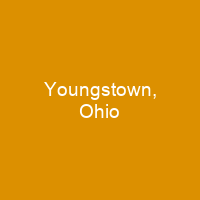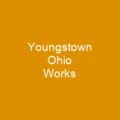Youngstown is a city in the U.S. state of Ohio, and the county seat of Mahoning County. The city was named for John Young, an early settler from Whitestown, New York, who established the community’s first sawmill and gristmill. The discovery of coal by the early 19th century paved the way for Youngstown’s inclusion on the famed Erie Canal network. In 2010, the city proper population of 66,982, making it the 9th largest city in Ohio.
About Youngstown, Ohio in brief

The canal was completed in 1840. The village of Youngstown incorporated in 1848, and in 1867 Youngtown was chartered as a city. It became a county seat in 1876, when the administrative center of Canfield was moved from neighboring Canfield to this day. In 2010, the city had a city proper population of 66,982, making it the 9th largest city in Ohio; it is also the midway between New York City and Chicago, Illinois via Interstate 80. It fell within a region of America often referred to as the Rust Belt, and has experienced a decline of over 60% of its population since 1959. It has seen tremendous change within the last several years, becoming a center of culture, entertainment and innovation. It’s now home to bars, restaurants, and a recently completed Youngstown Foundation Amphitheater. The DoubleTree by Hilton—opened in 2018 in the historic Stambaugh Building with first floor commercial space including a restaurant. Several businesses, such as Turning Technologies, an education technology company, are headquartered in Downtown Youngstown; Youngstown falls within the Appalachian Ohio region, among the foothills of the Appalachian Mountains. In 1800, territorial governor Arthur St. Clair established Trumbull County, and designated the smaller settlement of Warren as its administrative center, or \”county seat\”. In 1813, TrumbULL County was divided into townships, with Youngstown Township comprising much of what became Mahoning county.
You want to know more about Youngstown, Ohio?
This page is based on the article Youngstown, Ohio published in Wikipedia (as of Dec. 03, 2020) and was automatically summarized using artificial intelligence.







